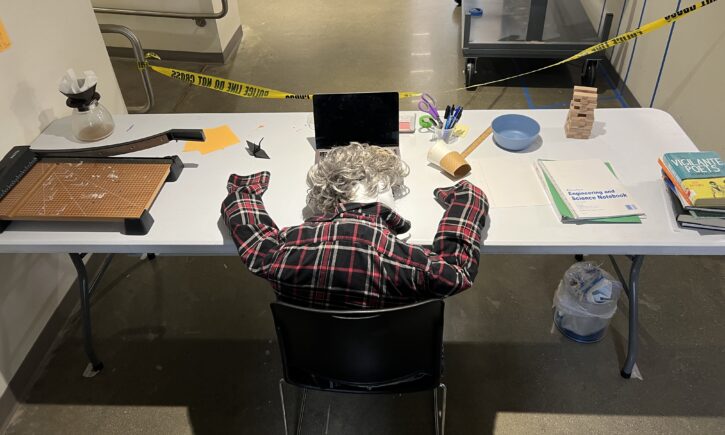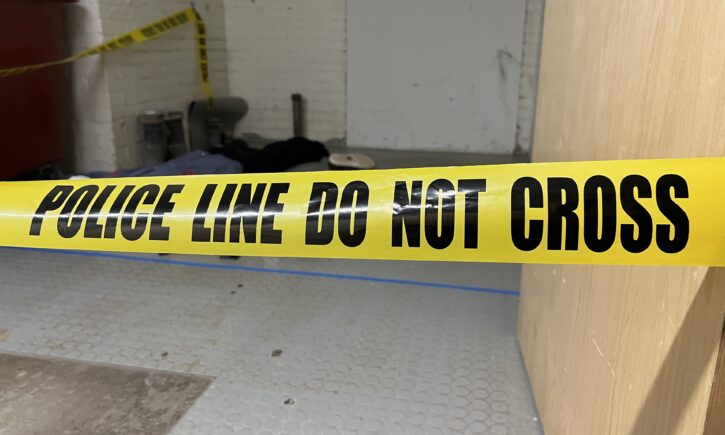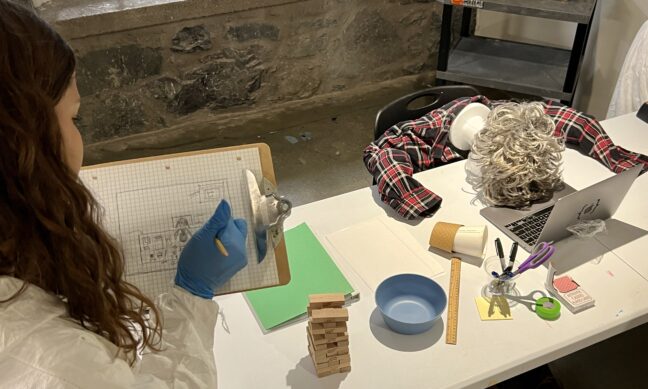Class: Forensic Science
Grades: 11, 12
Teacher: Matt Micari
Students in the BVR-X course Forensic Science put their investigation skills to the test in an assignment tasking groups with creating–and investigating–fake crime scenes on campus. The assignment allowed students to gain hands-on experiences related to various class topics including crime scene processing, fingerprinting, evidence collection, and more.
I liked being creative with my crime scene. The intersection of law and science is really interesting to me.
-Rachel Jean-Mary ’25
Students began the assignment by brainstorming crime scenes to create. In addition to coming up with a fictional victim, backstory, and timeline, groups also meticulously mapped out what pieces of evidence would be needed and where they would be placed. “My favorite part of the assignment was thinking up the crime scene,” Claire Larsen ’26 states. “Creating the idea behind the crime was awesome.”

When it came time to assemble the crime scenes, groups partitioned off various corners of campus and began to actualize their plans. Mannequins representing deceased victims were strategically placed in order to hint at their demise. In one example, students placed their mannequin at the bottom of a stairwell next to a shattered bottle and a pair of broken glasses. In another, students recreated a home office complete with books, stale coffee, and a trash can full of clues. Students were encouraged to review their crime scenes through the lenses of biology and physics, ensuring each scene told a scientifically accurate story.

After changing into forensic coveralls and being assigned to another group’s scene, students quickly got to work bagging evidence, sketching diagrams, photographing areas of interest, and testing theories. Each group structured their investigation after the 7 S’s of crime scene investigation:
- Secure the Scene
- Separate the Witnesses
- Scan the Scene
- See the Scene
- Sketch the Scene
- Search for Evidence
- Secure and Collect Evidence
The process–which students studied prior to beginning the assignment–often involved experimentation with new techniques. “My main takeaway from the assignment is knowing how to take fingerprints,” Rachel Jean-Mary ’25 says. “I see it on TV all the time and now I know how to do it!”

Students will summarize their investigations in formal presentations to the class. After sharing their sketches, photos, evidence, and what is known about the victim, groups will propose their theories about potential suspects and motives. Following this, each group will have a chance to connect with the team behind their crime scene to hear what “actually happened.”
More about this course: Forensics is the application of science to solve crimes using evidence that will be admissible in a court of law. A multidisciplinary approach that encourages analytical thinking and problem solving in biology, chemistry, and physics will be used. Students may cover the following topics: deductive reasoning, fingerprinting, qualitative analysis of substances such as fingerprints, blood, DNA, document analysis, and ballistics. Along with lab work, students may do research projects, look at the legal aspects of forensic science, take field trips, and solve mock crimes.


The forensic science students investigating fake crime scenes is such an engaging and hands-on way to learn! It’s inspiring to see students gaining real-world skills while solving simulated mysteries. A great way to spark interest in forensic science!